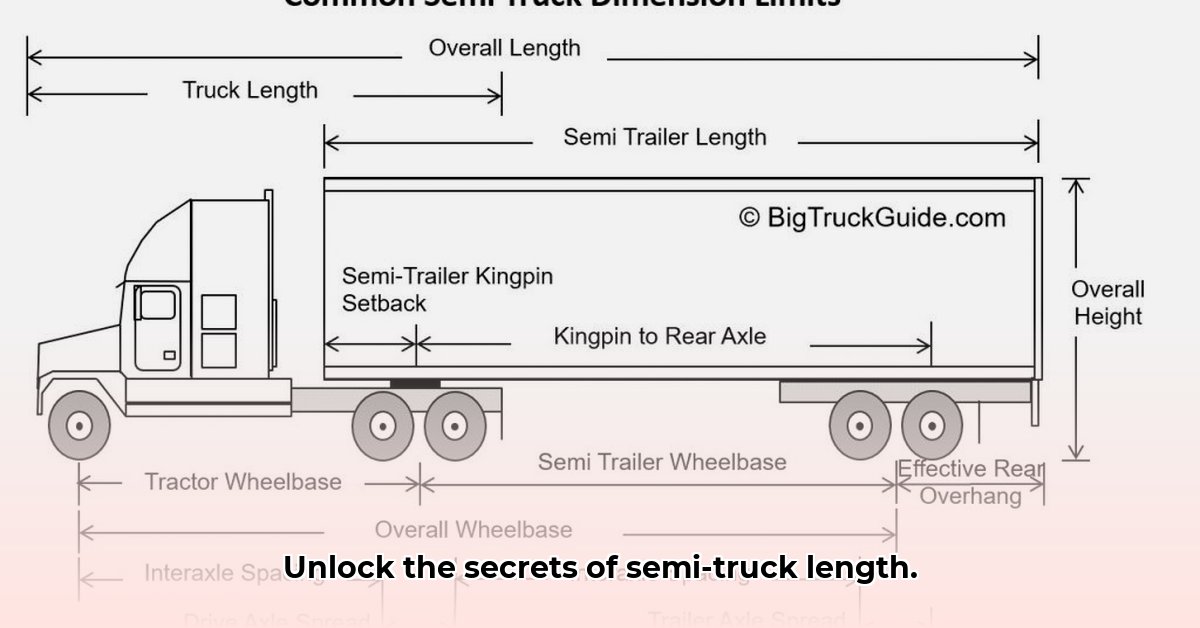
Understanding semi-truck lengths is crucial for safety, legal compliance, and efficient operations. However, the seemingly simple question of "how long is a semi-truck?" has a complex answer, varying significantly based on several factors. This guide provides a comprehensive overview, equipping drivers, logistics managers, and regulatory personnel with the knowledge to navigate this intricate landscape. For more on sleeper cab dimensions, see this resource.
Standard Dimensions: Setting the Baseline
Before diving into the complexities of length variations, let's establish the standard width and height dimensions. Across most of the continental U.S., semi-trucks generally measure 8.5 feet wide. However, an exception exists in Hawaii, where trucks can be slightly wider, up to 9 feet. Height restrictions are typically determined by bridge clearances and other infrastructure limitations. A common maximum height is around 13.5 feet although the Federal Highway Administration standard is 14 feet. It's crucial to remember that weight restrictions also significantly impact operations, with combined weight limits often set at 80,000 pounds. Why are these standard dimensions important? Because they are the foundation upon which length calculations are built.
The Length Enigma: Deconstructing the Variability
The length of a semi-truck is far from standardized. Reported average lengths vary widely, often ranging from 70 to 75 feet. This significant discrepancy stems from several key factors:
- Cab Type: Sleeper cabs, offering overnight accommodations for drivers, are considerably longer than day cabs, which are designed for daily trips. This difference can easily add several feet to the overall length.
- Trailer Type: The type of trailer significantly impacts the overall length. A standard 53-foot dry van trailer is common, but tankers, flatbeds, and specialized trailers can vary dramatically in length. A flatbed, for example, can be shorter or significantly longer, depending on the cargo.
- State Regulations: State-specific regulations further complicate the calculation. Each state dictates its own maximum allowable length, making nationwide consistency almost impossible. This necessitates careful planning and adherence to state-specific rules, which can change from state to state.
Understanding these variations is essential for accurate length calculations and legal compliance.
Trailer Types and Their Length Contributions
Different trailer types contribute vastly different lengths to the overall truck length. Here's a breakdown:
- Dry Van: This ubiquitous trailer, used for general cargo, typically measures 53 feet. These trailers are the most common type.
- Reefer (Refrigerated): Similar in length to a dry van, but with added refrigeration units, slightly increasing the overall length. Refrigeration units add to the back and therefore increase the overall length.
- Tanker: Tanker trailer lengths vary greatly depending on the liquid's capacity and the tanker's design. Smaller tankers are significantly shorter than larger ones, meaning flexibility in overall length.
- Flatbed: The length fluctuates depending entirely on the hauled cargo; there's no standard length. Flatbeds are therefore the most unpredictable in relation to length.
- Pup Trailer: These shorter trailers, often around 28 feet, are frequently used in pairs or with a longer trailer, increasing overall length and complexity of calculation.
These varying lengths highlight the importance of meticulous calculation.
State-Specific Regulations: A Patchwork of Laws
Navigating the legal landscape is critical. State regulations on maximum semi-truck length vary considerably, even within the contiguous United States. For instance, some states, like Texas and Oklahoma, have higher maximum-length allowances compared to states like New York which have stricter limits. This makes route planning an extremely intricate process.
Simplified Overview (Always consult official sources for up-to-date regulations):
| State | Approximate Maximum Length (ft) | Notes |
|---|---|---|
| California | 65-75 (with permits) | Permits often required for longer lengths. |
| Texas | Up to 75 (with permits) | Permits often required for longer lengths. |
| Oklahoma | Up to 75 (with permits) | Permits often required for longer lengths. |
| New York | 65 | Generally stricter limits. |
| Florida | 75 (with permits) | Permits often required for longer lengths |
Disclaimer: This is a simplified representation. Official state DOT websites provide up-to-date and precise regulations.
Legal Ramifications: Permits and Penalties
Operating a semi-truck exceeding legal length limits carries significant repercussions. Oversized loads generally require special permits, often involving escort vehicles and restricted routes. Non-compliance can result in substantial fines, lengthy delays, and potential legal action.
Practical Applications: Actionable Advice
Understanding semi-truck lengths is not just a matter of legal compliance; it’s fundamental to safe and efficient operations. Here's how this knowledge applies to different roles:
For Truck Drivers: Precise measurements are crucial. Familiarize yourself with regulations in your operating areas. Use onboard measurement tools if available, and always double-check measurements to prevent accidents and costly violations.
For Logistics Managers: Utilize route planning software that incorporates state-specific length regulations. Accurate length data optimizes load planning, ensuring efficient and lawful operations.
For Trucking Companies: Invest in fleet management software that tracks dimensions and ensures regulatory compliance. Support industry initiatives advocating for standardized nationwide regulations.
Safety Implications: A Holistic Perspective
Accurately calculating and adhering to semi-truck length regulations is paramount for safety. Dimensional miscalculations significantly increase the risk of accidents, including collisions and rollovers. Driver training emphasizing dimensional awareness is crucial. The use of accurate measurement tools and detailed route planning, accounting for bridge heights and tight turns, are essential for safe operation.
Conclusion: The Importance of Precision
Mastering semi-truck lengths goes beyond simply following rules; it's about ensuring safe, efficient, and compliant operations. The details provided here offer a strong foundation, but ongoing awareness of evolving regulations and industry best practices is vital for success. Accurate length calculations are not just a bureaucratic formality; they are fundamental to the safety and effectiveness of the entire trucking industry.